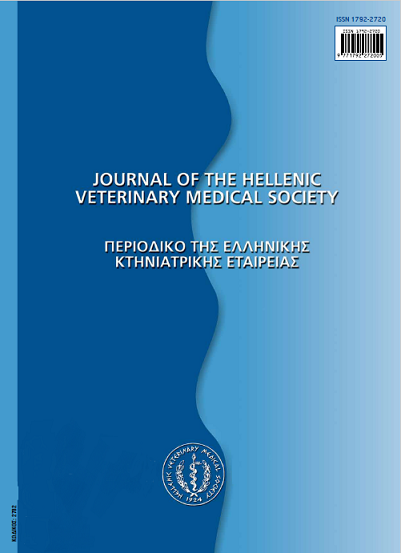Νεότερα δεδομένα πάνω στη θεραπεία της λεϊσμανίωσης του σκύλου

Περίληψη
Για τη θεραπευτική αντιμετώπιση της λεϊσμανίωσης του σκύλου χρησιμοποιούνται η αντιμονιοΰχος μεγλουμίνη, η αλλοπουρινολη, η παρομομυκίνη (αμινοσιδίνη) και η αμφοτερικίνη Β. Με μόνη εξαίρεση την αντιμονιοΰχο μεγλουμίνη όπου έγιναν φαρμακοκινητικές μελέτες(75 mg/Kg ΣΒ κάθε 12 ώρες, υποδόρια), τα δοσολογικά σχήματαγια την αλλοπουρινολη (10-20 mg/Kg ΣΒ κάθε 12 ώρες,από το στόμα), την παρομομυκίνη (5-10 mg/Kg ΣΒ κάθε12 ώρες, ενδομυϊκά ή υποδόρια) και την αμφοτερικίνη Β(0,5-0,8 mg/Kg ΣΒ, 2-3 φορές την εβδομάδα, μέχρι την ολικήδόση των 8-15 mg/Kg ΣΒ, ενδοφλέβια) βασίζονται στηνκλινική εμπειρία. Οι παρενέργειες από τη χορήγηση των δυο πρώτων φαρμάκων είναι σχετικά σπάνιες και ήπιες. Αντίθετα, η θεραπεία με παρομομυκίνη (ωτοτοξική, νεφροτοξική) και με αμφοτερικίνη Β (νεφροτοξική) μπορεί να συνοδεύεται από βαριές και επικίνδυνες για τη ζωή του ζώου παρενέργειες. Αν και με τα παραπάνω φάρμακα επιτυγχάνεται η κλινική ίαση στα περισσότερα ζώα και μειώνεται,χωρίς όμως να εξαφανίζεται, ο κίνδυνος μετάδοσης της Leishmania spp. στους φλεβοτόμους, η εξουδετέρωση του παρασίτου τις περισσότερες φορές δεν επιτυγχάνεται. Η μακροχρόνια θεραπεία με αλλοπουρινολη σε συνδυασμό με αντιμονιοΰχο μεγλουμίνη, σε κύκλους των 20-30 ημερών, θεωρείται το αποτελεσματικότερο και το λιγότερο τοξικό θεραπευτικό σχήμα. Η επανειλημμένη χρησιμοποίηση της αντιμονιοΰχου μεγλουμίνης συντελεί στην ανάπτυξη ανθεκτικών στελεχών του παρασίτου απέναντι στο φάρμακο αυτό. Η θεραπεία θεωρείται οριστική μόνο όταν το αποτέλεσμα της δοκιμής PCR στο μυελό των οστών είναι αρνητικόσε δυο διαδοχικές εξετάσεις, σε διάστημα 6 μηνών η μία από την άλλη. Η χρησιμοποίηση των κυτταροκινών INF-γ, IL-2,IL-12, που απελευθερώνονται από τα ενεργοποιημένα Th-1 λεμφοκύτταρα, ενδέχεται στο μέλλον να αυξήσει τις πιθανότητες για οριστική ίαση.
Λεπτομέρειες άρθρου
- Πώς να δημιουργήσετε Αναφορές
-
SARIDOMICHELAKIS (Μ. Ν. ΣΑΡΙΔΟΜΙΧΕΛΑΚΗΣ) M. N., KOUTINAS (Α.Φ. ΚΟΥΤΙΝΑΣ) A. F., & MYLONAKIS (Μ.Ε. ΜΥΛΩΝΑΚΗΣ) M. E. (2018). Νεότερα δεδομένα πάνω στη θεραπεία της λεϊσμανίωσης του σκύλου. Περιοδικό της Ελληνικής Κτηνιατρικής Εταιρείας, 52(2), 97–106. https://doi.org/10.12681/jhvms.15411
- Τεύχος
- Τόμ. 52 Αρ. 2 (2001)
- Ενότητα
- Special Article

Αυτή η εργασία είναι αδειοδοτημένη υπό το CC Αναφορά Δημιουργού – Μη Εμπορική Χρήση 4.0.
Οι συγγραφείς των άρθρων που δημοσιεύονται στο περιοδικό διατηρούν τα δικαιώματα πνευματικής ιδιοκτησίας επί των άρθρων τους, δίνοντας στο περιοδικό το δικαίωμα της πρώτης δημοσίευσης.
Άρθρα που δημοσιεύονται στο περιοδικό διατίθενται με άδεια Creative Commons 4.0 Non Commercial και σύμφωνα με την άδεια μπορούν να χρησιμοποιούνται ελεύθερα, με αναφορά στο/στη συγγραφέα και στην πρώτη δημοσίευση για μη κερδοσκοπικούς σκοπούς.
Οι συγγραφείς μπορούν να καταθέσουν το άρθρο σε ιδρυματικό ή άλλο αποθετήριο ή/και να το δημοσιεύσουν σε άλλη έκδοση, με υποχρεωτική την αναφορά πρώτης δημοσίευσης στο J Hellenic Vet Med Soc
Οι συγγραφείς ενθαρρύνονται να καταθέσουν σε αποθετήριο ή να δημοσιεύσουν την εργασία τους στο διαδίκτυο πριν ή κατά τη διαδικασία υποβολής και αξιολόγησής της.










